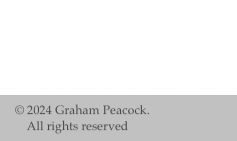 |
|
|
|
 |
 |
 |
|
|
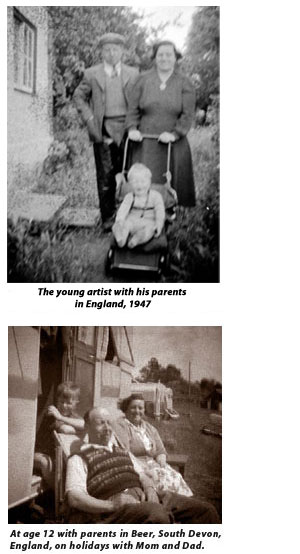 |
Chronology & List of Periods
Dates should not be taken as exact, but as general indicators of periods that drift in and out, and may result in some works being from former or later years. Paintings evolve over months, and sometimes years, in their various stages of completion, and on rare occasions may be reworked years later.
1945 – 1955
As a child Graham shows an inclination towards art. He attends St. Jude’s primary school, Herne Hill SE London, where he loves the art and music classes.
1956 – 1960
Paints watercolours on holidays with parents in Beer, South Devon. Enrolls in Tulse Hill School where there is a four year art program. Studies art history, drawing, painting, sculpture, ceramics, architecture and furniture design.
1962 – 1966
Attends London University’s Goldsmiths College of Art, London, England. Makes traditional studies from life, drawing, sculpting, painting, printmaking and ceramics. First abstractions, geometric paintings and sculpture made while a student.
|
|
|
|
|
|
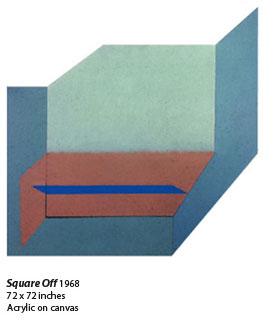 |
1966 – 1967
At Leeds College of Art, he works on a series of modular sculptures with plastics and aluminum which involves metal casting and working with a local plastics factory. He photographs these works, makes prints and becomes very involved in all these differing processes, but eventually returns to painting. Makes a group of shaped canvases that project from the wall. Influenced by the artist Richard Smith who visits the school.
1967 – 1968
Relocated to Newport, South Wales as Lecturer at the local art college, he continues painting influenced by John Walker and Mark Rothko. He paints canvases with geometric shapes suspended in atmospheric backgrounds. He is unable to complete much work due to lack of resources and low pay. Seeks other opportunities.
|
 |
|
|
1966 – 1967
At Leeds College of Art, he works on a series of modular sculptures with plastics and aluminum which involves metal casting and working with a local plastics factory. He photographs these works, makes prints and becomes very involved in all these differing processes, but eventually returns to painting. Makes a group of shaped canvases that project from the wall. Influenced by the artist Richard Smith who visits the school.
1967 – 1968
Relocated to Newport, South Wales as Lecturer at the local art college, he continues painting influenced by John Walker and Mark Rothko. He paints canvases with geometric shapes suspended in atmospheric backgrounds. He is unable to complete much work due to lack of resources and low pay. Seeks other opportunities.
|
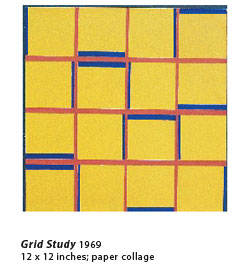 |
|
|
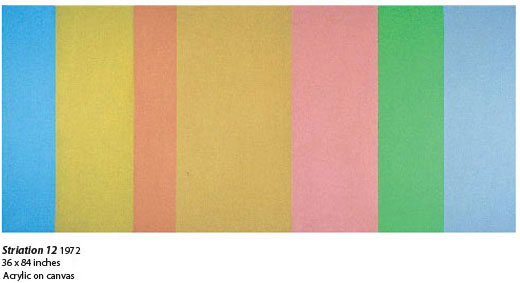
|
1969 – 1972 Striations
Arrives in Edmonton, Canada as a Lecturer at the University of Alberta, and has time and money. Begins working with horizontal and vertical bands of colour, initially with spraying and brushing soft edges, influenced by Mark Rothko. By 1971, turns to hard edge stained canvases, influenced by an interview he reads in Studio Magazine on how Kenneth Noland approached making a painting by the proportional balancing of colour. Makes a group of works entitled ‘Striations’.
|
|
|
1973 Working off the stretcher
Begins to experiment for the first time with loose all-over painting having discovered the work of Jackson Pollock, Jules Olitski, and Larry Poons. The painting Heller (below), in the collection of the Edmonton Court House, is one of a few remaining examples. Working on long lengths of canvas for the first time produced very few successful works. Most of the work from this time was eventually destroyed. He meets Poons and Olitski in their New York studios. Also meets Michael Steiner, Dan Christensen and Clement Greenberg.
|
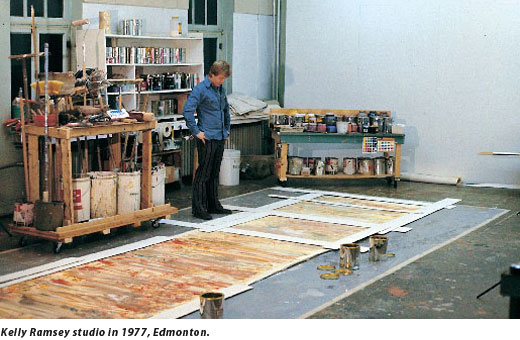
|
|
|
|
|
|
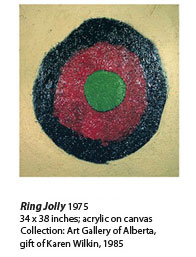 |
1974 Centres
Having cast around looking for some way to compose openly, he returned to using a compositional motif of circular bands. This allowed him to place all of the loose painterly handling he had acquired in the previous years into circular bands of colour.
|
|
|
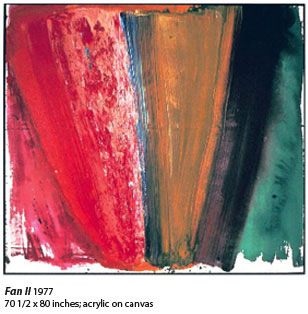 |
1975 Pillars and Fans
He paints a large group of paper works in Marlboro, New York entitled the ‘Marlboro Suite,’ in which he explores many differing types of banded compositions. He continues painting on canvas with a motif of horizontal and vertical bands of colour, spreading these into fanned formations. Often these painted motifs were floated in the middle of bare canvas. These works allowed for all kinds of applications such as rollers, squeegees, rakes, and brooms, mixing the colours often directly on the canvas.
|
|
|
1976 Screens
He is seeking to combine colour with all-over painting and completes a group of works painted by brooming transparent glazed colours over solid colour grounds and pouring in shapes. A solo exhibition is held of the ‘Screens’ at Latitude 53 Gallery in 1976. He also makes some works on paper.
|

|
|
|
 |
The Memorial Suite
Following the ‘Screens’, he makes a group of works in black and brown glaze colours in which he tries many forms of mark-making with all sorts of instruments using thick glazes, in a continued search for a new way of drawing. His father died that summer, thus the ‘Memorial Suite’ was dedicated to his memory.
The Patricia Suite – Stained florals
What followed was the pouring of large quantities of stains, making a group of large-scale floral motif paintings. Clement Greenberg thought them “too gratuitous” but unknown at the time, these were the beginning of the poured process that was to follow in 1981 and become decisive in his development by 1982. 1977 – 1978 These were years of experimentation with all-over painting, searching for new ways of working, inspired as he was with Larry Poons’ cascade mode of painting, and his objective of discovering the paintings composition out of the painting process. Most of the work of this time was also unsuccessful and was eventually destroyed.
|
|
|
1979 – 1980 The first appearance of crazing
Makes a group of paper works in which he pours small circles of gel in which a few fissures appear on drying. Attends the Emma Lake Artists’ Workshop with Kenworth Moffett as leader and begins adding collage with carpet and screening gels over the top. He continues screening pale transparent colour but this time pouring large circles of clear gels on top that would dry with crazed separations in the centers. Two solo exhibitions of these works were shown at the Hazel Hett Gallery in 1980 and 1981.
1981 Realizing the potential of causing fissures in the paint – ‘crazing’
He also makes some heavy painted surfaces with rollers and throwing paint that have Poons-like character but are painted on the floor, unlike Poons’ vertical drip paintings. He makes a length of canvas in which this thick application begins to craze and a few long narrow paintings are made. The notion that he can stack colour in layers which will be revealed by the crazed separations in the paint becomes a focused idea. Development of the paint medium to produce crazing is resolved.
|
|
|
|
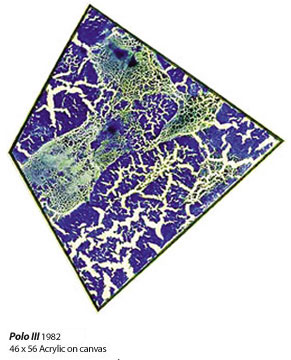 |
1982 The pursuit of induced crazing as a basis for a new form of picture making
He continues pouring deep formulations of his new paint medium, trying to induce this crazing which allows for one colour to be seen through another colour. A length of ultramarine blue over white becomes the first from which new works are made. These are titled the ‘Polo’ paintings, after the blue and white pottery that Marco Polo brought from Asia.
|
|
|
1982 – 1984 The early paintings with crazing
These years are characterized by fine crazing, with canvas collage pasted on the surface creating a change in scale of the crazing, producing a compositional emphasis. Angular shaping of mostly diamond-shaped canvases predominates as a compositional solution to the tendency for even, all-over patterning.
|
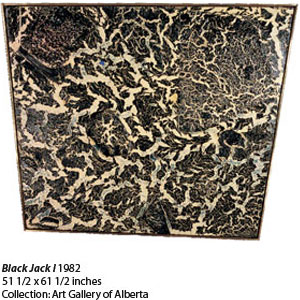
|
|
|
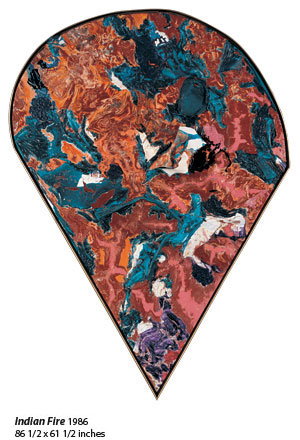 |
1984 – 1986 To up the scale of the crazing.
These are the formative years of increasing the colour range, scale of crazing, surface impasto, and exploring the pouring process of stacking layers of paint. Curves, as well as angular shaping are now present. The shaping of these early works was very ‘1960s geometric’ as the painting became more organic the paint formations suggested the potential for more irregular shaping.
|
|
|
1987 – 1988 Slabs – A return to the rectangle
In the ‘Slab’ paintings, instead of selecting angular cropped shapes from the painted lengths, he selects sections across the length of painted canvas, leaving the unpainted edges visible. The composition is like a suspended ‘slab,’ with the edges moving freely against the rectangular frame
|

|
|
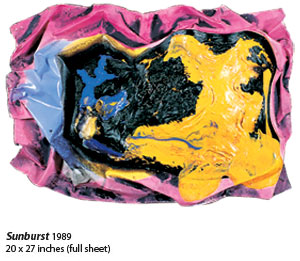 |
1987 – 1989 ‘Rocaille Suite’ – works on paper
Wanting to expand the loose shaping further, he returns to paper, pouring in small troughs and allowing the outer shape to become irregular, he undulates the surface of the paper by fixing these papers onto rag card. This series of papers indicates the possibilities and directions for the work for the next four or five years.
1989 – 1990 The beginning of irregular shaping
In response to the ‘Rocaille’ paper works, he begins to pour on canvas in individual troughs and gathers up and folds under the edges of the canvas and undulates the surface of the canvases. Mounting the painted canvas on a new canvas backing becomes the solution to holding the undulation and foam infilling in place, while providing the painting with a canvas backing that can then be stretched. The outside stretcher shapes become more irregular and begin to follow the internal movements of the paint.
|
1991 – 1993 Colour and Dimension – the dimensional paintings
He continues to pour paint on canvas in numerous troughs of colour, linking these troughs together during the drying process. The individual proportions, created by the size of the troughs, often resulted in suggesting a head and tail metamorphic animal reference, which was then cultivated in these works. The dimensional filling of the canvas and the outer shape became more pronounced. The edges were now tapered back at a 45° angle to the wall, and the contours became an expression of the internal colour formations.
|
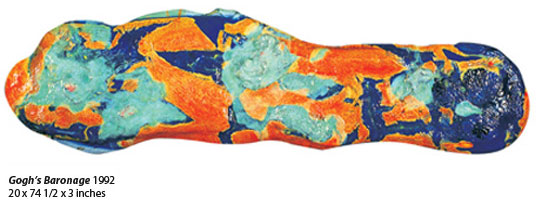 |
|
|
1993 – 1994 Circularity — the circular paintings
As the name suggests, there was a move towards a circular emphasis of shape. Following the previous work with highly referential shaping, his interest turns to internal colour movements and collaging optical reflectors and glass beads.
|
 |
|
|

|
1995 – 1996 Reflective and refractive – works in resin and glass
Finding limitations in the colour and reflective possibilities of traditional pigments, he makes a group of works in which he embeds glass, plastics, reflectors and holographic materials into a clear casting resin. These compositions are exhibited at The Edmonton Art Gallery in 1996 which are displayed at a 45° angle from the wall to induce refractions.
|
|
|
1995 – 1997 The Glitter paintings
The interest in optical light continues by the use of glitter as a surface and optical pigment on canvases that are predominantly circular or loosely oval in shape. Some of the outer edges of the supports were built up creating a dish-like effect with some canvases being slightly convex and concave.
|
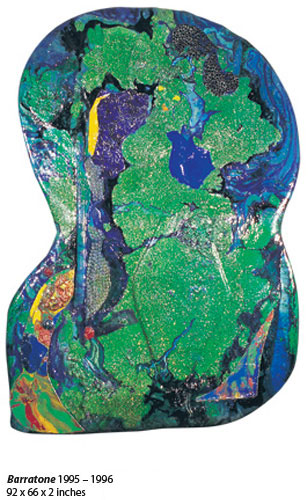 |
|
|
|
|
1999 – 2000 ‘Coeur de Lion’ paintings at Gallery One, Toronto
The exhibition was a show of mostly torso scale canvases, involving single colour themes and collage with painting skins and glass. The exhibition was reviewed in Art in America.
|
|
|
|
|
2000 The beginning of the cut-outs
The first cut-out, a removal of painted canvas from within a painting, occurred in the work The Magician. An unsuccessful colour was removed by cutting out a circle, which was replaced by fresh canvas that was then painted and shaded to look like a round ball. The idea that this presented, to combine three-dimensional illusion within his work, opened up a new set of possibilities.
|
|
|
2001 The Prague works
The Prague works combine strong tonal palette shifts with shapes that have simplified contours, vertical and horizontal in emphasis, but with overall curvilinear accents. Arabesque cut-outs feature in these works together with undulated surface illusions, glass, collage and painted shading. Five large works were shown at the National Gallery in Prague, Czech Republic, and two remain in their permanent collection.
|
|
|
2002 New New Illusionism
These works continue from the Prague works, with a generalized shaping and pronounced tonality of contrast, increasing of the illusionistic qualities, the cutting out of shapes and relocating them within the work. Undulating the surface to create illusions which were further accented by painted shadows was also increased. The title ‘New New Illusionism’ was given to the exhibition, and catalogue, when these works were shown in Toronto.
|
 |
2006, 2007, 2008, Painting in Italy
A total of four and a half months, over three years, instructing and painting watercolours in Vico Equense on the Gulf of Naples, Southern Italy for the University of Alberta. In 2008 he visits England and returns to his childhood home in London, St. Neots and Tempsford farm.
|
2005 – 2008
The illusionistic shaping, collaging and shading continued, though somewhat interrupted by a major studio relocation in 2005, from a studio that was occupied for 34 years. This coincided with the retrospective upon which this book is based. Much of the following three years have been spent on the assembly of this monograph. All of which has interrupted the progress of new work. A new series of works has begun which departs from the organic irregular shaping of the past work and introduces ‘parralex’ shaping, accentuating the optical illusion of the outside shape. The pronounced crazing of 1982 returns with the scale changes of later years…
…to be continued
|
|
|
|
|
|
|
|
|
|
|
|



